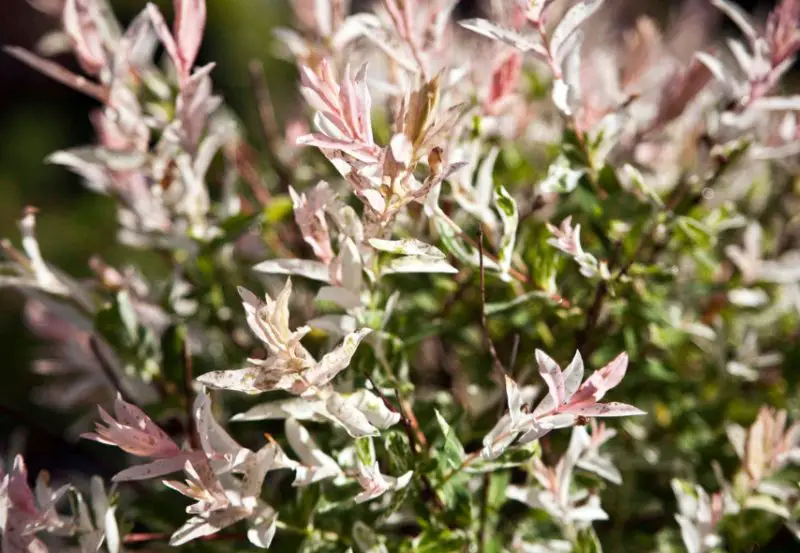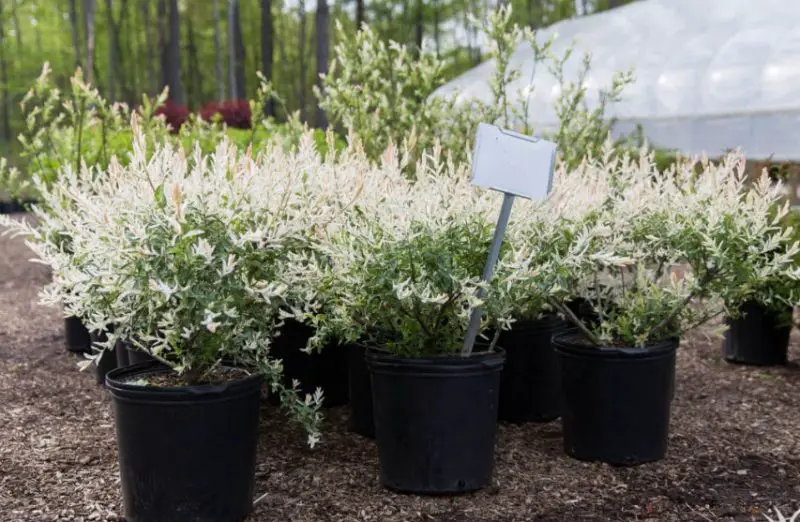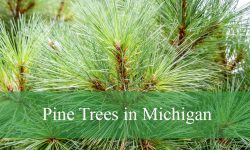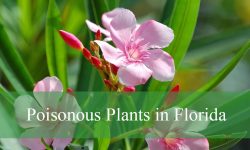The dappled willow tree is a fantastic and distinctive addition to any landscape if you’re trying to bring more than just a hint of color to your garden.
With its exquisitely arched branches, this little but exquisite tree defies description. Aside from its branches, gardeners and homeowners are amazed by its leaves when they change from a glossy pale pink to a green that almost seems white.
About Dappled Willow Tree

Dappled willow trees, scientifically known as Salix integra ‘Hakuro Nishiki’, are a strikingly beautiful and popular ornamental shrub cherished for their unique foliage and elegant appearance. Originating from East Asia, particularly Japan and Korea, these trees have found their way into landscapes around the world, captivating gardeners and nature enthusiasts alike with their charming features.
One of the aspects of the Dappled Willow Tree that attracts gardeners is its foliage. The leaves are variegated with shades of pink, white, and green, creating a mesmerizing dappled effect that lends the tree its name. In the spring, the new growth emerges as a vibrant pink, gradually maturing to a soft green throughout the summer months. This ever-changing color palette adds a dynamic element to any garden or landscape, providing visual interest year-round.
Besides, the dappled willow is prized for its versatility and ease of care. It is a deciduous shrub that typically grows to a moderate size, reaching heights of around 6 to 10 feet with a similar spread. Its compact, rounded form makes it an excellent choice for small gardens, containers, or as a focal point in larger landscapes. Additionally, dappled willows are known for their ability to thrive in a variety of soil types, including moist, well-drained soils, although they can tolerate occasional flooding.
Planting and Caring for Dappled Willow Trees

For optimal success when planting a dappled willow tree in your garden, it is advisable to choose either early spring or mid-to-late fall for planting. These seasons ensure favorable air temperatures and warm soil conditions, which are crucial factors for the successful establishment of dappled willow trees.
Light
When selecting a location for your dappled willow tree, prioritize areas with ample sunlight. While these trees can tolerate partial shade, they thrive best in locations that receive full sun. Optimal sun exposure enhances the vibrancy of the foliage, intensifying the colors of both the leaves and stems. Therefore, aim to plant your dappled willow in a spot where it can bask in sunlight for the majority of the day to ensure it achieves its full aesthetic potential.
Soil
Regardless of whether your chosen location offers partial shade or full sun, the soil texture plays a crucial role in the health and growth of dappled willow trees. These vibrant shrubs flourish in soil with a slightly acidic pH level, ideally ranging between 5 and 7. While they appreciate moist soil conditions, it’s essential to ensure proper drainage to prevent waterlogging. Dappled willow trees do not thrive in standing water, emphasizing the importance of moist, well-draining soil for their optimal growth and development.
Therefore, when preparing the planting site for your dappled willow, prioritize soil that is both slightly acidic and well-draining to provide the ideal environment for this stunning ornamental tree.
Planting
When planting a dappled willow tree, proper technique ensures its successful establishment and long-term health. Begin by digging a hole that is approximately one inch shallower than the height of the tree’s root ball and twice the diameter of its root ball. Carefully place the tree in the center of the hole, ensuring that the top of the root ball sits slightly above ground level.
Once the tree is in place, backfill the hole with soil, gently tamping it down around the roots to remove any air pockets. Water the newly planted tree thoroughly to settle the soil and provide essential moisture to the roots.
To further aid in moisture retention and weed suppression, apply a layer of mulch around the base of the tree, extending it out to a diameter of about three inches beyond the root ball. The mulch should be approximately three inches deep but kept away from the trunk to prevent moisture-related issues and potential rot.
Watering
Proper watering is essential for the health and vitality of dappled willow trees throughout their growth stages. During the first year of establishment, it’s crucial to provide regular watering to help the tree develop a strong root system. This initial period is when the tree is most vulnerable to moisture stress, so ensure the soil remains consistently moist but not waterlogged.
Once the dappled willow tree is established, typically after the first year, it becomes more tolerant of drought conditions. However, even established trees benefit from consistent moisture, particularly during hot and dry periods. Regular watering helps maintain the tree’s overall health and vigor, ensuring it continues to thrive and produce its signature vibrant foliage.
When watering, aim to moisten the soil evenly around the tree’s root zone, which typically extends out to the drip line. Avoid overhead watering, as this can promote fungal diseases and waste water through evaporation. Instead, use a soaker hose or drip irrigation system to deliver water directly to the soil at a slow and steady rate.
Monitor the moisture levels regularly, especially during periods of prolonged drought or high temperatures. Adjust your watering schedule accordingly to ensure the tree receives adequate moisture without becoming waterlogged.
Pruning
Pruning plays a crucial role in maintaining the health, shape, and overall aesthetic appeal of dappled willow trees. To ensure optimal results, it’s recommended to prune these ornamental shrubs during late winter or early spring, before the onset of new growth. This timing allows the tree to recover quickly from pruning stress and promotes vigorous regrowth during the upcoming growing season.
During the pruning process, focus on removing any dead, damaged, or diseased branches to improve the tree’s overall health and appearance. Additionally, take note of any branches that are crossing or rubbing against each other, as these can lead to damage and should be selectively removed.
By carefully shaping the tree through pruning, you can maintain its desired form and structure while encouraging healthy growth. Aim to create an open and airy canopy, which not only enhances the tree’s aesthetic appeal but also promotes better air circulation throughout the canopy. Improved air circulation helps reduce the risk of fungal diseases such as powdery mildew and ensures the tree’s overall vigor and longevity.
When pruning, use sharp, clean pruning tools to make precise cuts, minimizing the risk of tearing or damaging the tree’s bark. Make cuts just above a healthy outward-facing bud or lateral branch to encourage proper healing and new growth.
Fertilizing
Fertilizing is an important aspect of caring for dappled willow trees, as it provides essential nutrients to support their growth and foliage coloration. To promote vigorous growth and vibrant foliage, it’s recommended to apply a balanced fertilizer in early spring, just as the tree is emerging from its winter dormancy.
When selecting a fertilizer, opt for a balanced formula that provides a mix of nitrogen, phosphorus, and potassium, as well as micronutrients. These nutrients are essential for overall plant health and development. Follow the manufacturer’s recommendations regarding application rates and frequency, as over-fertilizing can lead to nutrient imbalances or damage to the tree’s roots.
Apply the fertilizer evenly around the base of the tree, extending it out to the drip line. Water the area thoroughly after application to help the fertilizer penetrate the soil and reach the tree’s roots. Avoid applying fertilizer too close to the trunk, as this can lead to fertilizer burn or damage to the tree.
Mulching
Mulching is a beneficial practice for maintaining the health and vigor of dappled willow trees, providing a range of advantages for both the tree and the surrounding environment. To effectively mulch around a dappled willow tree, apply a layer of organic mulch such as wood chips, shredded bark, or compost around the base of the tree. This layer of mulch serves several important purposes in promoting the tree’s well-being.
First and foremost, mulch helps retain moisture in the soil, reducing water loss through evaporation and ensuring the tree’s roots have access to consistent moisture levels. This is particularly beneficial during periods of drought or hot weather when water availability may be limited.
Additionally, mulch acts as a natural weed suppressant, smothering weed seeds and preventing them from germinating and competing with the tree for nutrients and moisture. This helps keep the area around the tree tidy and minimizes the need for manual weeding.
Furthermore, mulch helps regulate soil temperature, insulating the soil against temperature fluctuations and extremes. This is especially important during periods of extreme heat or cold, helping to protect the tree’s roots from stress and damage.
When applying mulch, be sure to keep it a few inches away from the trunk of the tree to prevent moisture-related issues such as rot or fungal diseases. Leave a gap between the mulch and the trunk to allow air circulation and prevent the bark from becoming excessively moist, which can attract pests and pathogens.
Protection from Pests and Diseases
Protecting dappled willow trees from pests and diseases is essential for maintaining their health and vitality. Common pests that may affect these trees include spider mites, caterpillars, and mildew. Fortunately, dappled willows are resilient plants, and most gardeners manage pest infestations by simply pruning infected stems and removing them from the tree.
However, anthracnose diseases, often caused by fungi, can pose a more significant threat to dappled willow trees, particularly during the growing season. Anthracnose can cause leaves to drop and lead to recurrent attacks that weaken the tree over time. If you observe signs of anthracnose infection, such as discolored or spotted leaves, it’s crucial to take action promptly. Remove and dispose of affected plant parts to prevent the spread of the disease and protect the overall health of the tree.






